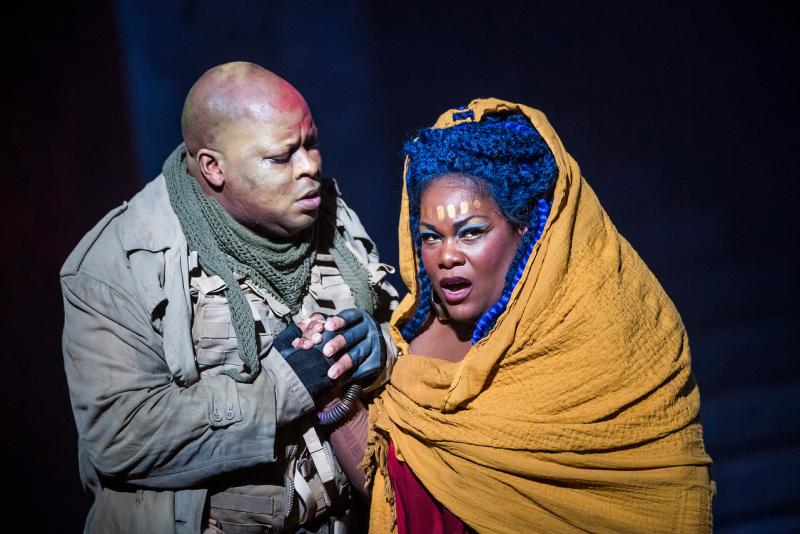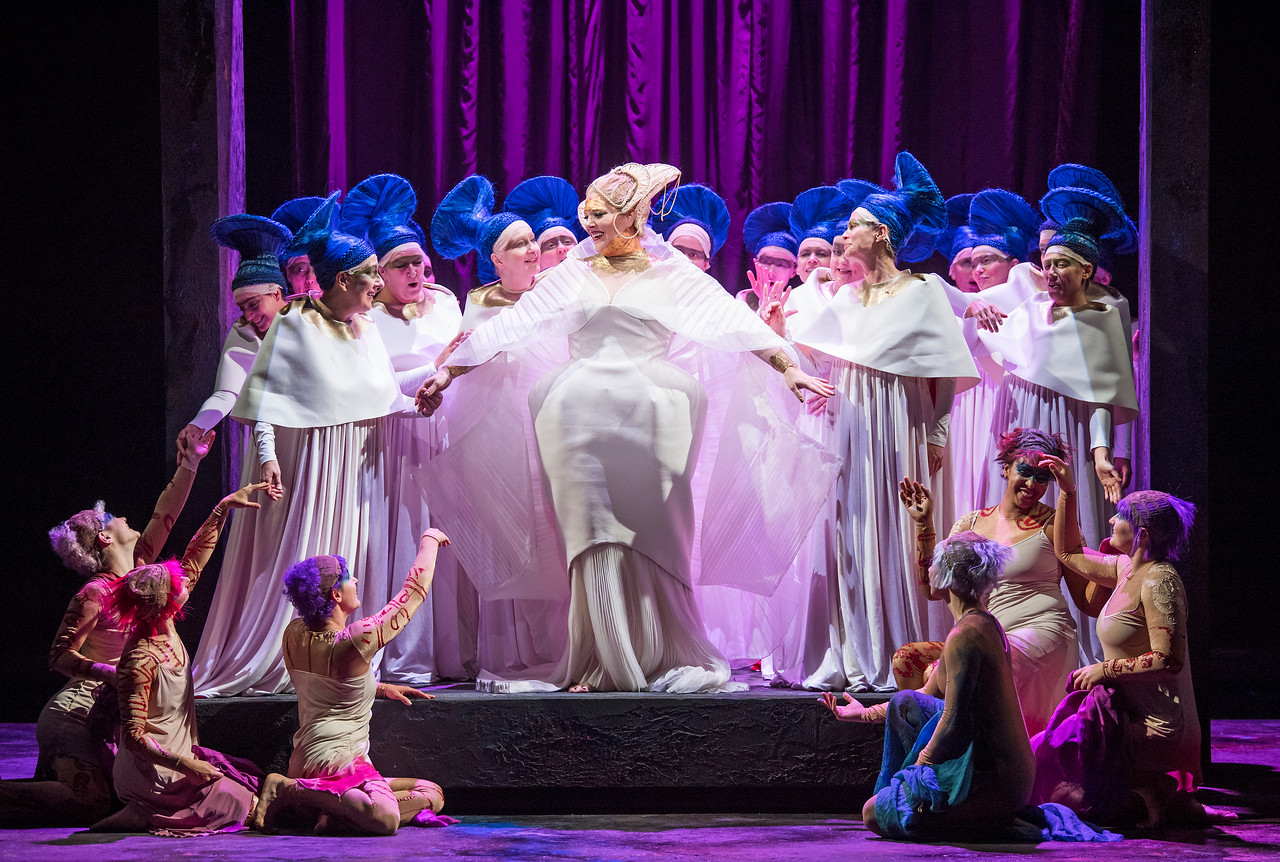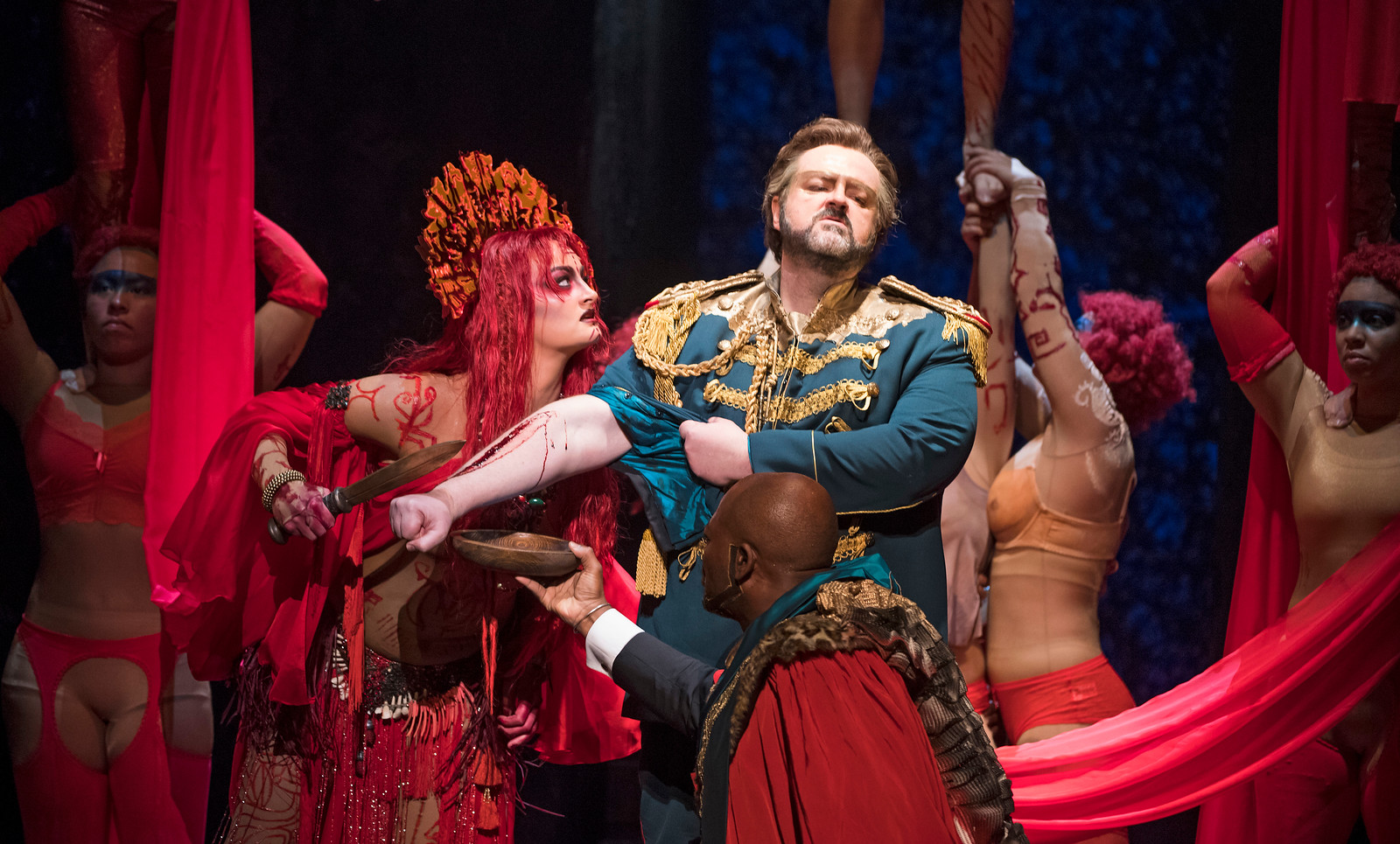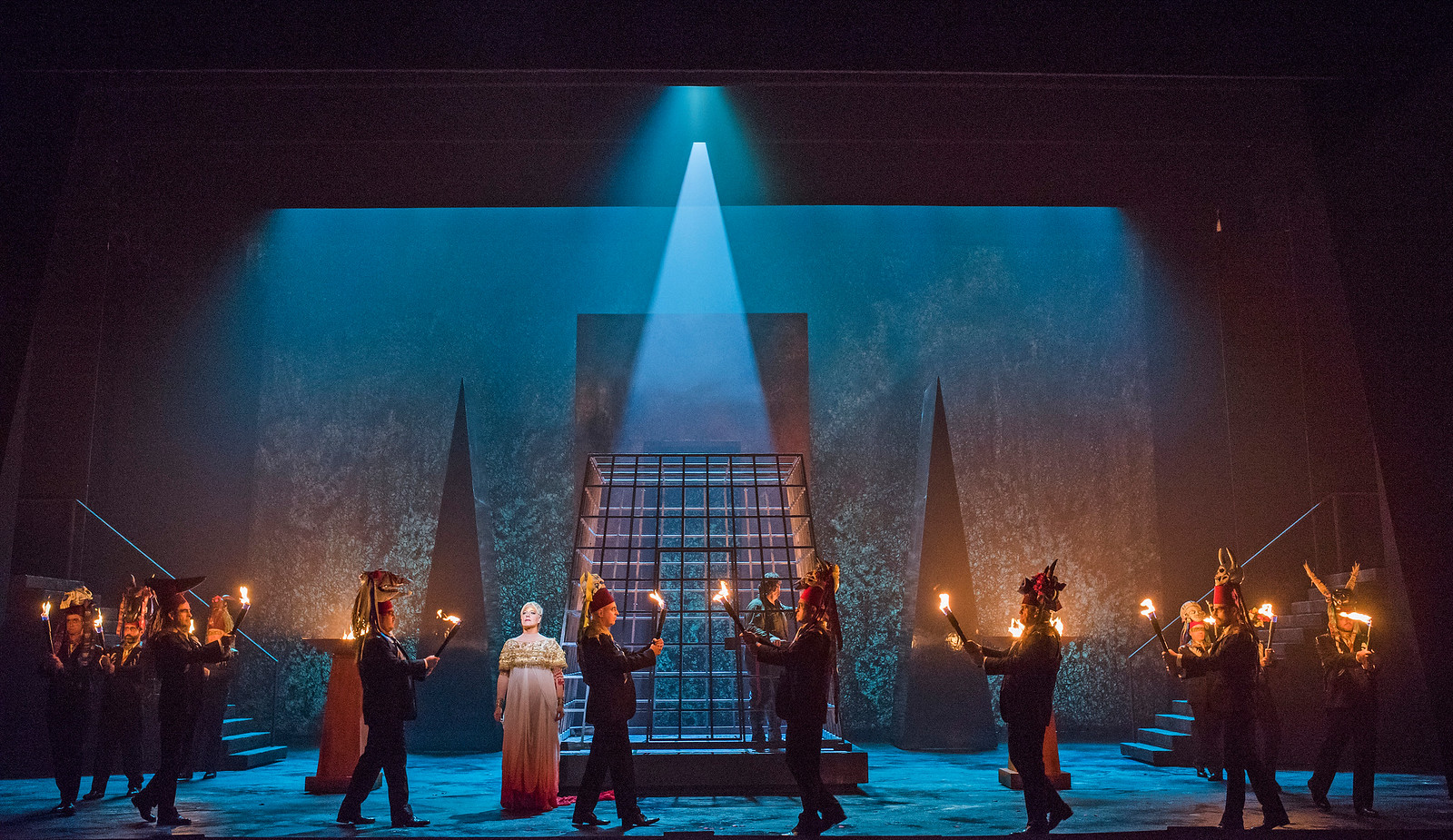Hand-crafted from start to finish: Salonen and the Philharmonia triumph with Mahler 3
From the score and from his letters, we know a lot about Gustav Mahler’s Symphony no. 3 in D minor, so you can do a great deal to prepare yourself for it before going into the concert hall: you can learn the concepts behind each movement (“Pan awakens” for the first, “What the flowers in the meadow tell me” for the second, and so on, you can learn about Mahler’s aspirations for the work, you can learn about Nietzsche’s poetry and all manner of details about how the score is constructed. But in the right hands – and yesterday afternoon at the Royal Festival Hall, Esa-Pekka Salonen and the Philharmonia’s hands were definitely the right hands – you don’t need any of that: just open your ears and your emotions and let the music take you where it will.

Michelle DeYoung, Esa-Pekka Salonen, Philharmonia
© David Karlin | Bachtrack Ltd
Whether or not the Third encompasses the whole of creation – as its composer aspired – what you will find is music which resonates with every part of your life: the sad bits, the cheerful bits, the hopeful, the scary, the nostalgic or schmaltzy bits, young love, mature love, grief, world-weariness, the times when you are proud of yourself, the times when you just need to calm down. Salonen proved an indefatigable and sure-footed guide.
Mahler’s big symphonies, of which the Third is up there with the biggest, are so long and complex that most conductors lose their grip on you at least once in the course of the evening: they just can’t keep you fully engaged and at one point or another, your mind wanders away from the music to other things. Salonen proved that, in Ira Gershwin’s words, “it ain’t necessarily so”. The most striking thing about this performance was the unflagging attention to detail: any phrase, however minor, from any section of the orchestra, was hand-crafted to create maximum effect.
The quality started at the very beginning, with the trombones phrasing a solid entry. From there, every instrument seemed to do just that little bit more than usual with their part – the clarion call of trumpets, threat from the cellos, a scream from oboes, powerful drive from the horns, later to be followed by ethereal release from flutes, cheekiness from the clarinets, perfectly timed acceleration from harp glissandi, and then, late in the movement, theatrics from the percussion as three pairs of clash cymbals crashed together. And then, a piece of true virtuosity from principal trombonist Byron Fulcher, morphing a harsh bray into utter lyricism, after which the strings and timpani took the music down to an exquisite calm.
On the podium, Salonen’s movement is spare: he is keeping time, with great clarity and precision even when the tempi are shifting rapidly, but he doesn’t employ the “do three things at once with different body parts” techniques of some conductors. I have to assume that all the hard work of sculpting the music, one bar at a time, has been done in rehearsal, and if that’s correct, this was one of the best rehearsed concerts I’ve ever attended.
Mezzo Michelle DeYoung made a telling contribution: an impressive figure on stage (DeYoung is as tall as Salonen plus height of podium combined), she intoned Nietzsche’s words “O Mensch” from the depths of the ages; her German diction was excellent and her commitment unquestionable. The fifth movement saw real dramatic tension between the grief in her solo role and the clarity and brightness of the Tiffin Boys Choir and Philharmonia Voices.
Over 90 minutes into the work, the intense string start to the last movement was augmented by yet another set of perfectly turned woodwind phrases, with colour and character as just about every phrase had been through all of the preceding music.
Mahler’s Third should be an impossibility – a work of ludicrously overarching ambition, a behemoth of a symphony with a 40-minute first movement hopelessly out of balance with the five that follow, a work that requires gigantic orchestral forces together with a soloist and choir who are only used for a small fraction of its length, music that veers erratically between contrasting styles.
But it works. In the end, it was DeYoung’s face that said it all. After finishing her part, she had been sitting at the front of the orchestra, concentrated on the music. As the texture of the music thickened steadily and wound up into the huge closing march, the pair of timpanists swayed to and fro, pounding their instruments with both sticks, even more powerful than Strauss’ famous opening to Also Sprach Zarathustra. DeYoung’s rapt half-smile turned into a broad grin, her face shining with the excitement that was nearly as evident in most of the audience at a triumphant exposition of Mahler’s immense conception.
&&&&&&&&&&&&&&&&&&&&&&&&&&&&&&&&&&&&&&&
Hand-crafted from start to
finish: Salonen and the Philharmonia triumph with Mahler 3
*****
By David Karlin, 02
October 2017
From the score and from
his letters, we know a lot about Gustav Mahler’s Symphony no. 3 in D minor, so
you can do a great deal to prepare yourself for it before going into the
concert hall: you can learn the concepts behind each movement (“Pan awakens”
for the first, “What the flowers in the meadow tell me” for the second, and so
on, you can learn about Mahler’s aspirations for the work, you can learn about
Nietzsche’s poetry and all manner of details about how the score is
constructed. But in the right hands – and yesterday afternoon at the Royal
Festival Hall, Esa-Pekka Salonen and the Philharmonia’s hands were definitely
the right hands – you don’t need any of that: just open your ears and your
emotions and let the music take you where it will.
Michelle DeYoung,
Esa-Pekka Salonen, Philharmonia © David Karlin | Bachtrack Ltd
Michelle DeYoung,
Esa-Pekka Salonen, Philharmonia
© David Karlin | Bachtrack
Ltd
Whether or not the Third
encompasses the whole of creation – as its composer aspired – what you will
find is music which resonates with every part of your life: the sad bits, the
cheerful bits, the hopeful, the scary, the nostalgic or schmaltzy bits, young
love, mature love, grief, world-weariness, the times when you are proud of
yourself, the times when you just need to calm down. Salonen proved an
indefatigable and sure-footed guide.
Mahler’s big symphonies,
of which the Third is up there with the biggest, are so long and complex that
most conductors lose their grip on you at least once in the course of the
evening: they just can’t keep you fully engaged and at one point or another,
your mind wanders away from the music to other things. Salonen proved that, in
Ira Gershwin’s words, “it ain’t necessarily so”. The most striking thing about
this performance was the unflagging attention to detail: any phrase, however
minor, from any section of the orchestra, was hand-crafted to create maximum
effect.
The quality started at the
very beginning, with the trombones phrasing a solid entry. From there, every
instrument seemed to do just that little bit more than usual with their part –
the clarion call of trumpets, threat from the cellos, a scream from oboes,
powerful drive from the horns, later to be followed by ethereal release from
flutes, cheekiness from the clarinets, perfectly timed acceleration from harp
glissandi, and then, late in the movement, theatrics from the percussion as three
pairs of clash cymbals crashed together. And then, a piece of true virtuosity
from principal trombonist Byron Fulcher, morphing a harsh bray into utter
lyricism, after which the strings and timpani took the music down to an
exquisite calm.
On the podium, Salonen’s
movement is spare: he is keeping time, with great clarity and precision even
when the tempi are shifting rapidly, but he doesn’t employ the “do three things
at once with different body parts” techniques of some conductors. I have to
assume that all the hard work of sculpting the music, one bar at a time, has
been done in rehearsal, and if that’s correct, this was one of the best
rehearsed concerts I’ve ever attended.
Mezzo Michelle DeYoung
made a telling contribution: an impressive figure on stage (DeYoung is as tall
as Salonen plus height of podium combined), she intoned Nietzsche’s words “O
Mensch” from the depths of the ages; her German diction was excellent and her
commitment unquestionable. The fifth movement saw real dramatic tension between
the grief in her solo role and the clarity and brightness of the Tiffin Boys
Choir and Philharmonia Voices.
Over 90 minutes into the
work, the intense string start to the last movement was augmented by yet
another set of perfectly turned woodwind phrases, with colour and character as
just about every phrase had been through all of the preceding music.
Mahler’s Third should be
an impossibility – a work of ludicrously overarching ambition, a behemoth of a
symphony with a 40-minute first movement hopelessly out of balance with the
five that follow, a work that requires gigantic orchestral forces together with
a soloist and choir who are only used for a small fraction of its length, music
that veers erratically between contrasting styles.
But it works. In the end,
it was DeYoung’s face that said it all. After finishing her part, she had been
sitting at the front of the orchestra, concentrated on the music. As the
texture of the music thickened steadily and wound up into the huge closing
march, the pair of timpanists swayed to and fro, pounding their instruments
with both sticks, even more powerful than Strauss’ famous opening to Also
Sprach Zarathustra. DeYoung’s rapt half-smile turned into a broad grin, her
face shining with the excitement that was nearly as evident in most of the
audience at a triumphant exposition of Mahler’s immense conception.





 Still, there’s spectacle, and everyone loves spectacle, except they might love this one a little bit less. It has its moments. The large, static choral scenes match the monolithic shapes of Tom Pye’s sets to some degree, there are some pretty colours, with rippling silk effects created by Basil Twist; and the beautiful, slanted, varied lighting by Bruno Poet is the subtlest thing on stage. But too often the static direction becomes almost ossified. Kevin Pollard’s timeless costumes don’t always help. Elaborate hieroglyph-inspired head-pieces, exotic venerations of Isis (ancient goddess, not so-called Islamic State), and Radames’s rather 19
Still, there’s spectacle, and everyone loves spectacle, except they might love this one a little bit less. It has its moments. The large, static choral scenes match the monolithic shapes of Tom Pye’s sets to some degree, there are some pretty colours, with rippling silk effects created by Basil Twist; and the beautiful, slanted, varied lighting by Bruno Poet is the subtlest thing on stage. But too often the static direction becomes almost ossified. Kevin Pollard’s timeless costumes don’t always help. Elaborate hieroglyph-inspired head-pieces, exotic venerations of Isis (ancient goddess, not so-called Islamic State), and Radames’s rather 19 None of the visuals would matter if the characters were fully explored and their interactions were vivid, but few were the moments when that happened; and instead of addressing one another, they mostly had to stand metres apart and bark forwards. Some crucial scenes barely featured eye contact.
None of the visuals would matter if the characters were fully explored and their interactions were vivid, but few were the moments when that happened; and instead of addressing one another, they mostly had to stand metres apart and bark forwards. Some crucial scenes barely featured eye contact. The chorus mostly stood and delivered, which they did extremely well, with the hushed moments especially fine. There was strong playing from the orchestra under the baton of Keri-Lyn Wilson, who took often brisk tempi and provided solid support to her soloists’ voices, mainly without drowning them in orchestral splendour and cavernous Coliseum space.
The chorus mostly stood and delivered, which they did extremely well, with the hushed moments especially fine. There was strong playing from the orchestra under the baton of Keri-Lyn Wilson, who took often brisk tempi and provided solid support to her soloists’ voices, mainly without drowning them in orchestral splendour and cavernous Coliseum space.
